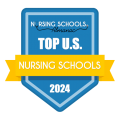For our 2024 rankings, the research team at Nursing Schools Almanac collected data on nearly 3,000 nursing schools and campuses throughout the United States. We evaluated each school on three dimensions:
Search for nursing schools and programs in your state:
Oklahoma has three primary nursing roles. In order of increasing responsibility and pay, these roles are certified nursing assistant (CNA), licensed practical nurse (LPN), and registered nurse (RN). Each nursing role carries distinct educational requirements.
Certified nursing assistants must complete a brief certificate program. This CNA certificate can be earned in eight to ten weeks at a number of community colleges and technology centers throughout Oklahoma. The state’s CNAs earn a median annual salary of $21,490.
The job market for nurses is promising in the coming years, particularly in South Carolina which is projected to experience a 24% nursing staff shortage according to the U.S. Bureau of Labor Statistics (BLS). For those looking to capitalize on this shortage and pursue a fulfilling career in nursing, several potential roles are profiled below in order of increasing seniority, educational requirements, and compensation.
The state of Colorado offers some excellent accredited nursing schools that provide students with high-quality training. A career in nursing offers many possible paths. You might start out as a nursing assistant, or perhaps choose to become a licensed practical nurse and then a registered nurse. Following this, it’s possible to specialize in a particular area, such as nursing anesthesia, midwifery, or nurse practitioner.
Home to a variety of programs, Minnesota offers prospective nursing students a wide array of options. In order to find the right educational path, it is important to understand the different roles available to candidates.
For aspiring nurses in Worcester, Massachusetts, it is critical to understand the available career paths and the key attributes of the city’s top nursing programs.
Washington DC is home to a number of accredited nursing schools dedicated to helping students launch careers in the healthcare field. As a nurse, you have a wide field of career options available, each one requiring a different level of education. Each of these nursing paths also requires successfully passing a licensure or certification examination at the conclusion of your studies.
The first step in launching a nursing career is understanding the different pathways available. Aspiring nurses in the Tampa Bay metropolitan area of Florida can select from three potential nursing roles.
St. Louis is Missouri’s second-largest city, and it is home to some of the state’s best and largest hospitals. These include Barnes-Jewish Hospital at Washington University, which houses 1,130 doctors; Missouri Baptist Medical Center, home to 690 doctors; and St. Luke’s Des Peres Hospital, with 363 residing doctors. The support staff at these healthcare centers is immense, and it includes many of the state’s top nurses. In order to join this community, aspiring nurses must obtain the proper education, training, and credentials. Fortunately, St.
The city of Seattle has the largest population of nurses in the state of Washington. It is also home to several of the state’s most prestigious nursing schools, including the University of Washington, Seattle University, Pacific Lutheran University, and Seattle Pacific University.
What does it take to become a registered nurse (RN), licensed vocational nurse (LVN), or certified nursing assistant (CNA) in the San Francisco Bay metropolitan area? Because RNs must perform a variety of challenging tasks – including administering treatments and medications, establishing care plans, and operating complex medical equipment – hospitals and healthcare providers require an associate degree in nursing (ADN), bachelor of science in nursing (BSN), or master of science in nursing (MSN). Many employers prefer a BSN or MSN degree.















